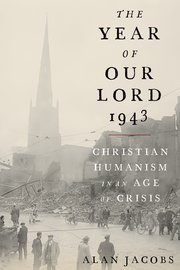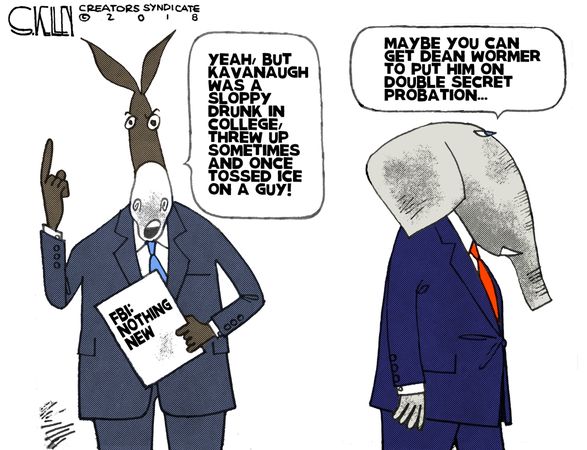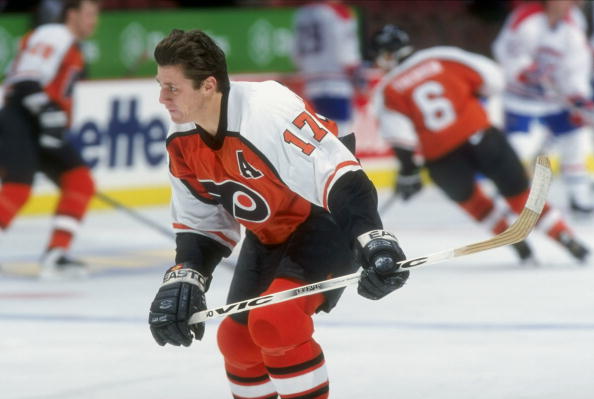By Julie Kelly
October 5, 2018

Bret Stephens (Real Time)
The headline was a stunner: “For Once, I’m Grateful For Trump.”
Even more shocking was the column’s author: New York Times columnist Bret Stephens.
At great risk of alienating his Trump-hating readership at theTimes, Stephens carefully explained why he is relieved a man he detests now sits in the Oval Office. From evidence-free accusations against Judge Brett Kavanaugh to grandstanding, hypocritical senators, Stephens admitted he was reluctant to make such a heretical confession in the pages of a newspaper committed to destroying the Supreme Court nominee:
I’m grateful because Trump has not backed down in the face of the slipperiness, hypocrisy and dangerous standard-setting deployed by opponents of Brett Kavanaugh’s nomination. I’m grateful because ferocious and even crass obstinacy has its uses in life, and never more so than in the face of sly moral bullying. I’m grateful because he’s a big fat hammer fending off a razor-sharp dagger.
The piece was not well-received by Times readers. As of Friday morning, there were more than 3,500 comments, mostly tantrums by progressives about Stephens’s viewpoint.
The attempted political assassination of Brett Kavanaugh has triggered an epiphany for NeverTrump “conservatives” such as Stephens. Some of Trump’s most vicious and vocal critics on the Right are shockedthat the Left has orchestrated such a craven crusade against a decent man, alarmed that their progressive compatriots are so desperate for power that they would seek the destruction of an innocent man’s career, his reputation and his family while bulldozing long-cherished standards of decorum and law to prevail where they failed at the ballot box.
They now realize—just as millions of Americans did back in November 2016 and have appreciated in the months since—that Trump is the only bulwark between us and a leftist junta intent on annihilating everything we value and anyone who gets in their way. It has been, to rephrase a famous taunt, their “But, Kavanaugh!” moment.
Writing at Townhall this week, Erick Erickson—who called himself one of the “original NeverTrump conservatives”—said he is for the first time is considering voting for Trump in 2020. Seth Mandel, an editor at the New York Post, admitted that the Kavanaugh allegations were rallying his fellow Trump foes behind the president. “In the days leading up to the hearing, I started noticing something: Mild-mannered anti-Trump conservatives would, in private conversations, fume at Kavanaugh’s treatment and insist Democrats had crossed a line and could not be appeased.”
National Review’s Jonah Goldberg turned on the elite media for how they’ve fueled the Kavanaugh travesty. Goldberg first explained that he abhors when the president calls the media the “enemy of the people” because it sounds authoritarian—but then proceeded to produce a litany of examples why the media is indeed the enemy of the people. Then this advice to his journo-pals: “You might also consider why millions of people love it when Trump says you are the enemy of the people: It’s because of how you are behaving right now,” Goldberg warned. “You’re letting the mask slip. You’re burning credibility at such a rate, you won’t have enough to get back to base when this is all over.”
Where Have They Been?
Those of us who have been subjected to NeverTrump’s scorn; who have defended the president in his darkest days while being mocked by Trump foes; who have been called every name in the book from racist to homophobes to stupid are tempted to say, “better late than never.” But not without first turning a mirror toward these antagonists and apologists for the Left so they own up to the dystopia they have helped create.
For two years, NeverTrump has united with the Left to sabotage Trump’s presidency, smear congressional Republicans who support him, and ridicule Trump voters. Led by Bill Kristol, the editor-at-large-and-getting-larger of the Weekly Standard, this group is as culpable as the news media and Democratic politicians for the smoldering hellscape that now is American politics.
NeverTrump has bolstered the sham special counsel probe into phony claims of election collusion between the Trump campaign and the Kremlin; they have joined the Left on several occasions to demand that the president be removed from office—in late August, Stephens insisted the president’s actions met the “high crimes and misdemeanors” standard for impeachment. They mock Trump supporters with the childish, “But, Gorsuch!” mantra at every presidential misstep, an insult aimed at Americans who voted for Trump singularly out of concern about the future composition of the Supreme Court.
Many NeverTrumpers including National Review’s Goldberg and David French have helped legitimizeMichael Avenatti, the creepy porn lawyer also trying to take down Kavanaugh. The president has been compared to Adolf Hitler and Mussolini by this crowd, while they compare themselves to courageous dissidents who fought communism. “Expert” Tom Nichols claimed Trump voters are ruining the country, and the Washington Post’s reprehensible Jennifer Rubin condoned violence against Trump aides, including Sarah Sanders, the first mother to serve as White House press secretary.
As part of #TheResistance, NeverTrumpers landed sweet gigs on CNN and MSNBC—not because they are intelligent or even photogenic—but because they are quick with an inflammatory remark about Trumpworld. It has been a profitable endeavor as they sell books and earn speaking fees for their Trump-hating views.
So now some NeverTrumpers have grown a conscience when it comes to the mistreatment of Trump appointees and allies? The Kavanaugh hit job is the result of a steady and successful trajectory of attacks on other Trump associates.
Where were they when the Left ruthlessly and relentlessly harassed EPA administrator Scott Pruitt and his family? Oh yes, they were chiming in alongside the New York Times: some finally capitulated to the environmental bullies and demanded Pruitt’s resignation.
Collusion of the Worst Sort
What did NeverTrump say when the Left came for Dr. Ronny Jackson? Or Gen. Michael Flynn? Or Reps.Devin Nunes and James Jordan? Or even Trump’s wife and family? They can’t even speak up when MSNBC pundits claim Trump wants to round up people and kill them, or when the media mock the murder of a college girl in Iowa.
Where was NeverTrump’s defense of Carter Page, a former naval officer who was targeted by his own government, spied on for a year, and vilified in the news media? According to some NeverTrumpers, Page deserved what he got. They have aided the obstruction of a full investigation into widespread corruption at the Justice Department, warning Republicans that any questioning of the FBI is an attack on law enforcement. Many have shielded from scrutiny folks such as former FBI Director James Comey and his henchmen Andrew McCabe and Peter Strzok.
On every issue, big and small, NeverTrump worked in lockstep with the media, Hollywood and the Democratic Party to undermine Trump’s presidency and damage anyone aligned with him.
There are still NeverTrump holdouts. Kristol, Nichols, Rubin and Boot are not just opposing Kavanaugh’s nomination but urging people to vote for Democrats this fall, which would empower the very thugs who are leading this assault on our political system and our democracy. Nichols argued that Kavanaugh’s conduct is worse than the Democrats, and accused him of buying into conspiracy theories. So NeverTrumper nutters still abound.
But their numbers are shrinking, and it’s only a matter of time before they turn on each other. That will be a gratifying scene to watch unfold. Sadly, the pile of post-2016 political wreckage lies all around us, with Brett Kavanaugh now in the center of the debris. And NeverTrump, even those now seeking atonement, is as responsible for this as anyone.





